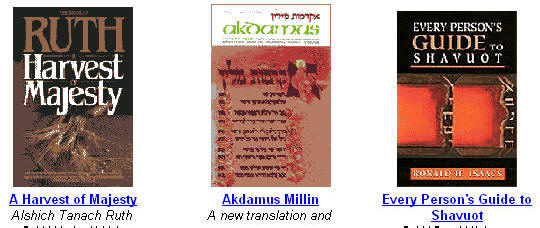
|
| • Holiday Gifts |
| Holiday Central > Shavuot > Meaning and Purpose |
By: Rivka C. Berman, Contributor
Click Here for More Holiday Articles

With a market basket of symbols, customs and inner meanings, the holiday of Shavuot arrives on the 6th of Sivan, June 6th and 7th, 2008. A quick look at Shavuot’s many names helps explain this festival. Two names closely associate the holiday with Temple rites in ancient Jerusalem: Shavuot and Chag Hakatsir. While modern day practice is enriched by viewing Shavuot through its third name, Zman Matan Torateinu.
- Shavuot - Pentecost
- Shavuot in Temple Times
- Why A Bread Offering?
- Chag Hakatzir - The Harvest Festival
- First Fruit Ceremony at the Temple
- First Fruits Today
- Zman Matan Torataynu - Anniversary of Receiving the Torah
Shavuot - Pentecost
Shavuot is Hebrew for "weeks."
Seven weeks are counted from the day following the beginning of Passover
for a total of 49 days. (Leviticus 23:15) The fiftieth day ushers in
Shavuot, hence the name Pentecost, which is Greek for "fifty."
Shavuot in Temple Times
During the seven weeks between Passover
and Shavuot, the Temple was busy with a special ceremony called the omer,
an omer is an ancient measurement, that was brought as a wave offering.
A special set of publicly harvested barley grains were winnowed,
toasted, ground, sifted, mixed with oil, formed into a dough and waved
in the courtyard of the Temple before a portion was sprinkled onto the
altar as a sacrifice. Afterward all new grains were permitted for
harvesting and eating.
On Shavuot a different sort of ritual was performed with the first of the wheat. Unlike all other gift offerings that were accompanied by matzah, Shavuot featured a two-loaf bread offering (in addition to a roundup of bulls, rams, and goats). Fine flour with a sourdough starter formed the basis for the square loaves. Kohanim, who served in the Temple, would consume the bread after it had been waved in different sections of the Temple.
Why a Bread Offering?
Many commentators puzzle over this
unusual offering. Bread is a basic food, no matter what the
low-carbohydrate diet promoters claim. God is said to be the sustainer
of all, and yet it takes much human intervention (growing, harvesting,
winnowing, grinding, measuring, mixing, kneading and baking) to make
just one loaf. To begin the harvest season with holy loaves renewed
humanity’s partnership with God in feeding the world.
Chag Hakatsir – The Harvest Festival
In another spot in the Torah, Shavuot is
given a different twist.
"Three times of year you should keep a feast for me…and the feast of the harvest, the first fruits of your labors which you have sown in the field." (Exodus 23:13-16)
The three major holidays mentioned referred to in these verses have agricultural ties. First Passover is celebrated in the spring, when the earth awakens from its winter dormancy. Next is Shavuot when the first fruits and grains would be harvested. Finally, Sukkot is observed when the fully ripened bounty would be gathered. These holidays would find the farmer alternately thanking and beseeching God for a successful planting season. Setting a festival amid the feverish planting, harvesting, gathering called every farmer to acknowledge God’s hand in nature.
Shavuot, along with the other two festivals, was a time of oleh regel (literally, going up on foot). Women and children, young men and old would troop into Jerusalem to observe the holidays together. In ancient times, Shavuot really must have been an incredible celebration.
First Fruits Ceremony at the Temple
Each family carried a basket of first
fruits to the Temple in Jerusalem. Baskets would be filled with
Israel’s seven fruits that were mentioned in Deuteronomy 8:8: "A
land of wheat and barley and vines and fig and pomegranates a land of
olive oil and [date] honey."
So many people descended upon Jerusalem during the shalosh regalim, the three festivals, that archeologists have found what they think were massive hotel-like structures among the Temple mount rubble.
The fruits, known as bikkurim, were the first produce of the season. As soon as farmers noticed signs of ripening, they would tie reed strings around the first fruits as a marker and declared them "bikkurim." Though rabbis advised farmers to give one-sixtieth of their crops as bikkurim, farmers gave according to their means.
Historic accounts describe the bikkurim procession. Traveling by district, villagers would march accompanied by music until they reached the Temple Mount. Runners would advise Temple officials of the group’s imminent arrival. A welcoming committee, proportional to the size of the group would be sent to greet the olim, those who came up to Jerusalem.
Before entering the Temple courtyard, villagers would take few moments would be to rearrange the produce that had gotten jostled along the way. Then all baskets would be hoisted onto the shoulders of their owners. Kohanim, Temple priests, would help each person say the bikkurim prayer. (Deuteronomy 26:3-10) The kohen would wave the fruit in a prescribed manner. All fruits and most of the baskets were presented to the kohanim as gifts. (Leviticus 23:17-20)
First Fruits Today
Except for the few token weekend
gardeners, most of us leave food growing up to agribusiness
conglomerates. What lessons can be learned from the first fruits today?
-To give of ourselves. Giving away a first fruit is a true gift. Farmers worked and worried about drought, blight, flies, rots and worms. They toiled. Sweat mixed with tears, soil and debt. To let these first fruits go to the Temple took a measure of self-sacrifice. To give first fruits (your time, your energy, your love) is a holy act.
-Equality. Everyone was obligated to bring bikkurim, from the impoverished subsistence farmer to the king. Everyone had to feel the weight of the fruit on their shoulders.
Zman Matan Torateinu
– The Anniversary
of Receiving the Torah
Later when the sacrificial rites were
halted after the destruction of the central ancient Temple in Jerusalem,
the rabbis redirected the holiday’s meaning. Shavuot became a
celebration of the giving of the Torah. Surprisingly, no date is given
for the stand at Mt. Sinai. Some commentators explain this is because we
are to feel the Torah and her teachings are new to us each day.
Based on some scriptural hints, the rabbis equated Shavuot with Zman Matan Torateinu, the time of receiving the Torah. (The rabbis created Chanuka and Purim, too.) Many of Shavuot’s observances reflect this understanding of the holiday.

Mazor Guide to Shavuot, Pentecost, brings you much more about the holiday, its meaning and its traditions... See the links below.
- Shavuot Home
- Shavuot Purpose and Meaning
- Shavuot Customs and Traditions
- Shavuot Celebrations and Blessings
- The Story of Ruth and Naomi
- Reading Ruth: Rhyme and Reason.
- Shavuot Hidden Facts and Messages
- Shavuot and the Number Six
- Shavuot Cookbooks
MazorGuide Recommended Reading
 RUTH
- ArtScroll Edition
RUTH
- ArtScroll Edition
A new translation with a commentary
anthologized from Talmudic, Midrashic and Rabbinic sources
The ArtScroll Series presents the comments of the classic giants of ancient and contemporary times in a logical, comprehensible manner, like a master teacher on an exciting voyage of intellectual discovery.
- Entire Hebrew text reset in clear modern type
- Flowing English translation
- Commentary anthologized from 2,000 years of Talmudic and Rabbinic sources
- Overviews exploring the hashkafah/philosophical background of each volume.
To Be A Jew: A Guide To Jewish Observance In Contemporary Life
(Paperback)
by Hayim H. Donin (Author)
|
|
|
|

|
| • Holiday Gifts |
|
|
 |
| • Celebrations Gifts |
|
·
Wedding Gifts · Bar Mitzvah Gifts · Baby Gifts · Jewish Books at Great Prices |
KOSHER BY DESIGN Amazing New Kosher Cookbook. BUY |
Mazor Guides: Wealth of Information and Resources
- Mazor Guide - The Ultimate Guide to
Living Jewish -
- Guide to Jewish
Holidays -
-
Bar Mitzvah
and Bat Mitzvah Guide -
-
Guide to a
Jewish Wedding -
-
Guide to Jewish Celebrations -
-
Guide to Kosher Living -
- Infertility and
Judaism: A Guide -
- The Get (Gett)
- the Jewish Divorce: A Guide -
- Zei
Gezunt: Jewish Perspective on Health -
- Jewish Genetic Diseases -
-
Death and Mourning in
Judaism -
Copyright 1998-2024 MazorNet, Inc.
| http://www.MazorGuide.com | http://www.MazorBooks.com | http://www.Kosher-Directory.com | http://www.JewishCelebrations.com





